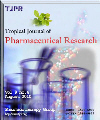
|
Tropical Journal of Pharmaceutical Research
Pharmacotherapy Group, Faculty of Pharmacy, University of Benin, Benin City, Nigeria
ISSN: 1596-5996
EISSN: 1596-5996
Vol. 15, No. 4, 2016, pp. 877-883
|
 Bioline Code: pr16118
Bioline Code: pr16118
Full paper language: English
Document type: Research Article
Document available free of charge
|
|
|
Tropical Journal of Pharmaceutical Research, Vol. 15, No. 4, 2016, pp. 877-883
| en |
Bioequivalence evaluation of new microparticulate capsule and marketed tablet dosage forms of lornoxicam in healthy volunteers
Shah, Pervaiz Akhtar; Bashir, Sajid; Ahsan, Muhammad; Abbas, Nasir; Malik, Muhammad Zubair & Nazar, Hafiz Muhammad Irfan
Abstract
Purpose:
To compare oral bioavailability and pharmacokinetic parameters of different lornoxicam
formulations and to assess similarity in plasma level profiles by statistical techniques.
Methods:
An open-label, two-period crossover trial was followed in 24 healthy Pakistani volunteers (22
males, 2 females). Each participant received a single dose of lornoxicam controlled release (CR)
microparticles and two doses (morning and evening) of conventional lornoxicam immediate release (IR)
tablet formulation. The microparticles were prepared by spray drying method. The formulations were
administered again in an alternate manner after a washout period of one week. Pharmacokinetic
parameters were determined by Kinetica 4.0 software using plasma concentration-time data. Moreover,
data were statistically analyzed at 90 % confidence interval (CI) and Schuirmann’s two one-sided t-test
procedure.
Results:
Peak plasma concentration (Cmax) was 20.2 % lower for CR formulation compared to IR
formulation (270.90 ng/ml vs 339.44 ng/ml, respectively) while time taken to attain Cmax (tmax) was 5.25
and 2.08 h, respectively. Area under the plasma drug level versus time (AUC) curve was comparable for
both CR and IR formulations. The 90 % confidence interval (CI) values computed for Cmax, AUC0-24, and
AUC0-∞ , after log transformation, were 87.21, 108.51 and 102.74 %, respectively, and were within predefined
bioequivalence range (80 - 125 %).
Conclusion:
The findings suggest that CR formulation of lornoxicam did not change the overall
pharmacokinetic properties of lornoxicam in terms of extent and rate of lornoxicam absorption.
Keywords
Analgesic; Microparticles; Controlled release; Lornoxicam; NSAIDs; Pharmacokinetics
|
| |
© Copyright 2016 - Tropical Journal of Pharmaceutical Research
Alternative site location: http://www.tjpr.org
|
|
